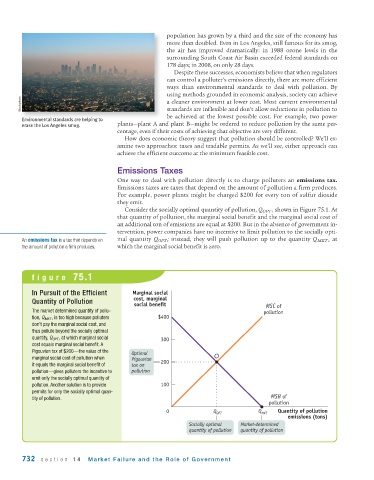Page 774 - Krugmans Economics for AP Text Book_Neat
P. 774
population has grown by a third and the size of the economy has
more than doubled. Even in Los Angeles, still famous for its smog,
the air has improved dramatically: in 1988 ozone levels in the
surrounding South Coast Air Basin exceeded federal standards on
178 days; in 2008, on only 28 days.
Despite these successes, economists believe that when regulators
can control a polluter’s emissions directly, there are more efficient
ways than environmental standards to deal with pollution. By
using methods grounded in economic analysis, society can achieve
iStockphoto a cleaner environment at lower cost. Most current environmental
standards are inflexible and don’t allow reductions in pollution to
be achieved at the lowest possible cost. For example, two power
Environmental standards are helping to
erase the Los Angeles smog. plants—plant A and plant B—might be ordered to reduce pollution by the same per-
centage, even if their costs of achieving that objective are very different.
How does economic theory suggest that pollution should be controlled? We’ll ex-
amine two approaches: taxes and tradable permits. As we’ll see, either approach can
achieve the efficient outcome at the minimum feasible cost.
Emissions Taxes
One way to deal with pollution directly is to charge polluters an emissions tax.
Emissions taxes are taxes that depend on the amount of pollution a firm produces.
For example, power plants might be charged $200 for every ton of sulfur dioxide
they emit.
Consider the socially optimal quantity of pollution, Q OPT , shown in Figure 75.1. At
that quantity of pollution, the marginal social benefit and the marginal social cost of
an additional ton of emissions are equal at $200. But in the absence of government in-
tervention, power companies have no incentive to limit pollution to the socially opti-
An emissions tax is a tax that depends on mal quantity Q OPT ; instead, they will push pollution up to the quantity Q MKT , at
the amount of pollution a firm produces. which the marginal social benefit is zero.
figure 75.1
In Pursuit of the Efficient Marginal social
Quantity of Pollution cost, marginal
social benefit MSC of
The market determined quantity of pollu- pollution
tion, Q MKT , is too high because polluters $400
don’t pay the marginal social cost, and
thus pollute beyond the socially optimal
quantity, Q OPT , at which marginal social 300
cost equals marginal social benefit. A
Pigouvian tax of $200—the value of the Optimal
marginal social cost of pollution when Pigouvian 200 O
it equals the marginal social benefit of tax on
pollution—gives polluters the incentive to pollution
emit only the socially optimal quantity of
pollution. Another solution is to provide 100
permits for only the socially optimal quan-
MSB of
tity of pollution.
pollution
0 Q OPT Q MKT Quantity of pollution
emissions (tons)
Socially optimal Market-determined
quantity of pollution quantity of pollution
732 section 14 Market Failure and the Role of Gover nment

